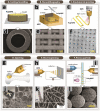Fundamentals and Design-Led Synthesis of Emulsion-Templated Porous Materials for Environmental Applications
- PMID: 34553500
- PMCID: PMC8596121
- DOI: 10.1002/advs.202102540
Fundamentals and Design-Led Synthesis of Emulsion-Templated Porous Materials for Environmental Applications
Abstract
Emulsion templating is at the forefront of producing a wide array of porous materials that offers interconnected porous structure, easy permeability, homogeneous flow-through, high diffusion rates, convective mass transfer, and direct accessibility to interact with atoms/ions/molecules throughout the exterior and interior of the bulk. These interesting features together with easily available ingredients, facile preparation methods, flexible pore-size tuning protocols, controlled surface modification strategies, good physicochemical and dimensional stability, lightweight, convenient processing and subsequent recovery, superior pollutants remediation/monitoring performance, and decent recyclability underscore the benchmark potential of the emulsion-templated porous materials in large-scale practical environmental applications. To this end, many research breakthroughs in emulsion templating technique witnessed by the recent achievements have been widely unfolded and currently being extensively explored to address many of the environmental challenges. Taking into account the burgeoning progress of the emulsion-templated porous materials in the environmental field, this review article provides a conceptual overview of emulsions and emulsion templating technique, sums up the general procedures to design and fabricate many state-of-the-art emulsion-templated porous materials, and presents a critical overview of their marked momentum in adsorption, separation, disinfection, catalysis/degradation, capture, and sensing of the inorganic, organic and biological contaminants in water and air.
Keywords: emulsion templating; environmental remediation; porous materials; sensing; water/air treatment.
© 2021 The Authors. Advanced Science published by Wiley-VCH GmbH.
Conflict of interest statement
The authors declare no conflict of interest.
Figures



















References
-
- a) Kuppusamy S., Venkateswarlu K., Megharaj M., Mayilswami S., Lee Y. B., Chemosphere 2017, 186, 607; - PubMed
- b) Awasthi A. K., Zeng X., Li J., Environmental pollution 2016, 211, 259; - PubMed
- c) Landrigan P. J., Fuller R., Fisher S., Suk W. A., Sly P., Chiles T. C., Bose‐O'Reilly S., Sci. Total Environ. 2019, 650, 2389; - PubMed
- d) Santibáñez‐Andrade M., Quezada‐Maldonado E. M., Osornio‐Vargas Á., Sánchez‐Pérez Y., García‐Cuellar C. M., Environmental pollution 2017, 229, 412. - PubMed
-
- a) Khin M. M., Nair A. S., Babu V. J., Murugan R., Ramakrishna S., Energy Environ. Sci. 2012, 5, 8075;
- b) Yasri N. G., Gunasekaran S., in Enhancing Cleanup of Environmental Pollutants, Springer, Berlin: 2017, p. 5;
- c) Huang D., Hu C., Zeng G., Cheng M., Xu P., Gong X., Wang R., Xue W., Sci. Total Environ. 2017, 574, 1599; - PubMed
- d) Dasgupta J., Sikder J., Chakraborty S., Curcio S., Drioli E., J. Environ. Manage. 2015, 147, 55; - PubMed
- e) Homaeigohar S., Elbahri M., Materials 2014, 7, 1017; - PMC - PubMed
- f) Lu F., Astruc D., Coord. Chem. Rev. 2020, 408, 213180;
- g) Maleki H., Chem. Eng. J. 2016, 300, 98;
- h) Ye S., Yan M., Tan X., Liang J., Zeng G., Wu H., Song B., Zhou C., Yang Y., Wang H., Appl. Catal., B 2019, 250, 78;
- i) Ye S., Zeng G., Tan X., Wu H., Liang J., Song B., Tang N., Zhang P., Yang Y., Chen Q., Appl. Catal., B 2020, 269, 118850.
-
- Samanta P., Desai A. V., Let S., Ghosh S. K., ACS Sustainable Chem. Eng. 2019, 7, 7456.
-
- Yang X.‐Y., Chen L.‐H., Li Y., Rooke J. C., Sanchez C., Su B.‐L., Chem. Soc. Rev. 2017, 46, 481. - PubMed
-
- Okesola B. O., Smith D. K., Chem. Soc. Rev. 2016, 45, 4226. - PubMed
Publication types
Grants and funding
LinkOut - more resources
Full Text Sources
